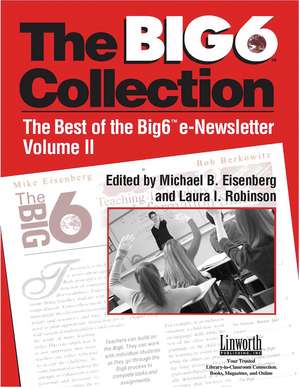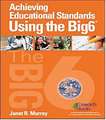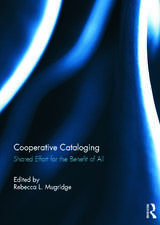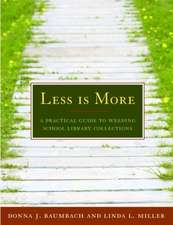Big6 Collection: Best of the Big6 eNewsletter, Volume II: Big6 Information Literacy Skills
Editat de Michael B. Eisenberg, Laura Eisenberg Robinsonen Limba Engleză Paperback – 31 dec 2004 – vârsta până la 17 ani
Preț: 232.38 lei
Preț vechi: 342.81 lei
-32% Nou
Puncte Express: 349
Preț estimativ în valută:
44.47€ • 48.29$ • 37.36£
44.47€ • 48.29$ • 37.36£
Carte tipărită la comandă
Livrare economică 22 aprilie-06 mai
Preluare comenzi: 021 569.72.76
Specificații
ISBN-13: 9781586831943
ISBN-10: 1586831941
Pagini: 304
Dimensiuni: 216 x 279 x 17 mm
Greutate: 0.75 kg
Editura: Bloomsbury Publishing
Colecția Linworth
Seria Big6 Information Literacy Skills
Locul publicării:New York, United States
ISBN-10: 1586831941
Pagini: 304
Dimensiuni: 216 x 279 x 17 mm
Greutate: 0.75 kg
Editura: Bloomsbury Publishing
Colecția Linworth
Seria Big6 Information Literacy Skills
Locul publicării:New York, United States
Notă biografică
Michael B. Eisenberg is dean emeritus and professor at the Information School of the University of Washington.Laura Eisenberg Robinson is the Special Education Teacher/Big 6 Project Manager at Seattle Public Schools in Seattle, Washington. Her published works include The Super3: Information Skills for Young Learners.
Recenzii
A comprehensive collection of their favorite parts of the Big6T eNewsletter, Eisenberg and Robinson have compiled this second volume to support information problem solving using the Big6 skills. This resource serves as a functional starting point for the Big6 newbie as much as it offers new applications of the Big6 skills to Big6 enthusiasts with this compilation of previously published articles-perhaps missed the first time around-by Big6 practitioners. Part 1 of this anthology restates and redefines the original Big6 skills. Other components address Big6 in action, divided into activities and suggestions for grade-specific activities for K-Higher Education, activities for use in the Arts, and activities for use with exceptional students. This volume addresses how to use Big6 with technology, how to teach information problem solving, and how to companion the skills with content standards. Clearly, I believe this volume is a beneficial tool for supporting information literacy growth in schools; and current explanations of Big6 skills and applications are less cryptic to educators than the original documents. Purchase this reasonably priced book if you have no Big6 books for professional use in your school or if you are an avid Big6 collector. Previous Big6 publications in your collection continue to suffice as generous resources. Recommended.




















